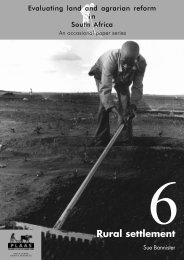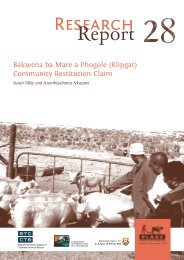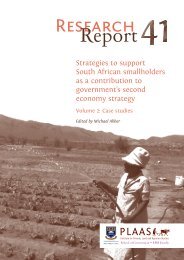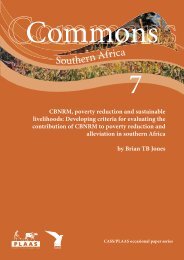A critical appraisal of South Africa's market-based land reform policy
A critical appraisal of South Africa's market-based land reform policy
A critical appraisal of South Africa's market-based land reform policy
Create successful ePaper yourself
Turn your PDF publications into a flip-book with our unique Google optimized e-Paper software.
Chapter 4: Background to Limpopo<br />
1995–99 were <strong>of</strong>ten <strong>of</strong> very poor quality<br />
with questionable viability. A study <strong>of</strong> <strong>land</strong><br />
<strong>reform</strong> in the then Northern Province at the<br />
end <strong>of</strong> 1998 identified serious problems<br />
with the nature <strong>of</strong> project identification,<br />
ineffective <strong>land</strong> acquisition, and inappropriate<br />
project planning (Lahiff 1998). 2<br />
By mid-1998, four years into the<br />
democratic dispensation, only three <strong>land</strong><br />
redistribution projects had been implemented<br />
in the province, a number which<br />
rose to seven by the end <strong>of</strong> 1998 (Lahiff<br />
1998). These redistribution projects were<br />
all on private <strong>land</strong> and appeared to be<br />
largely initiated by the <strong>land</strong>owners. This<br />
contributed to inappropriate project design<br />
and poor group dynamics as groups <strong>of</strong><br />
people were put together to ‘fit’ the <strong>land</strong><br />
rather than <strong>land</strong> being found to fit the<br />
needs <strong>of</strong> an existing group. The tailoring<br />
<strong>of</strong> groups to the <strong>land</strong> was done in order to<br />
combine the grants <strong>of</strong> R15 000 (later<br />
increased to R16 000) per family into a<br />
total grant amount sufficient for the purchase<br />
<strong>of</strong> the <strong>land</strong>. Unfortunately this<br />
process <strong>of</strong> combining grants was done<br />
with little consideration <strong>of</strong> other investments<br />
required for the farms to become<br />
productive.<br />
The state proved to be a very poor<br />
buyer <strong>of</strong> <strong>land</strong> with the long delays and<br />
uncertainties leading current owners who<br />
had been willing to sell to withdraw from<br />
deals. Lahiff recommended that either<br />
improvements be made to make the state a<br />
more effective agent for purchasing <strong>land</strong><br />
on the open <strong>market</strong>, or a <strong>policy</strong> shift be<br />
undertaken away from the willing sellerwilling<br />
buyer approach (Lahiff 1998). The<br />
project planning was found to be largely<br />
inappropriate, involving little consultation<br />
with beneficiaries and no consideration <strong>of</strong><br />
the current skills and experience <strong>of</strong> beneficiaries.<br />
There was also a strong emphasis<br />
on commercial farming, regardless <strong>of</strong> the<br />
interests and abilities <strong>of</strong> the beneficiaries,<br />
and no programme for building capacity<br />
amongst beneficiaries and their structures<br />
(Lahiff 1998).<br />
By the time the LRAD <strong>policy</strong> had<br />
been completed in 2001 there had been a<br />
considerable increase in SLAG delivery in<br />
terms <strong>of</strong> the numbers <strong>of</strong> hectares transferred<br />
and beneficiaries. At the beginning<br />
<strong>of</strong> this study early in 2003, DLA reported<br />
that 77 SLAG projects had been implemented<br />
for 6 753 households which gained<br />
access to a total <strong>land</strong> area <strong>of</strong> 45 110ha.<br />
However according to DLA <strong>of</strong>ficials, the<br />
organisational and production problems<br />
with the projects created remained as<br />
severe as before (interview 3).<br />
Endnotes<br />
1. For more details refer to page 25 <strong>of</strong> Part 1,<br />
Livelihoods <strong>of</strong> farm workers in <strong>South</strong> African<br />
agriculture (Department <strong>of</strong> Labour 2001).<br />
2. The name <strong>of</strong> the province changed in 2002.<br />
17
















